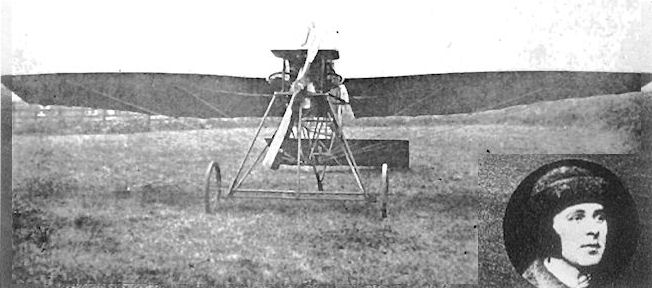
Описание
Страна: Великобритания
Год: 1909
P.Lewis British Aircraft 1809-1914 (Putnam)
Watkins Monoplane
The Watkins single-seat tractor monoplane was designed and built during 1909 by C. Horace Watkins of Wales. Watkins constructed every part of the machine himself, including the three-cylinder 40 h.p. engine which was also of his own design and used castings made in a local foundry to his patterns. Orthodox wooden construction with wire bracing was employed for the airframe, the undercarriage consisting of cycle tubing with brazed joints. Originally a tailwheel was fitted, but this was replaced by a tailskid after the first tests. Many ingenious features were incorporated in the design, among them being three positions for the attachment of the undercarriage. The first of these was immediately below the engine so that the front fuselage could be used as an engine test-bed; the second position was one bay to the rear of the first position, which permitted taxying under full power without risk of taking-off or of nosing-over; the third position was two bays behind the first position and incorporated the undercarriage just forward of the C.G. and in the normal flight location. The aerofoil-section oil tank was mounted in front of the centre cylinder of the engine for maximum cooling. Flight instruments comprised a spring-loaded vane-type indicator for air speed which was mounted on top of the cabane, a caged-ball form of inclinometer to indicate the degree of bank applied, and a vertical wind-vane to show side-slip or yaw. The tachometer consisted of a 4 volt D.C. dynamo which was driven by the engine and was connected to a voltmeter to register up to about 1,200 r.p.m.
Watkins found that when tests were made in broad daylight they drew sight-seeing crowds who damaged the gates and hedges of the land from which he had permission to fly, so he had to confine his activities to the periods before dawn or after sunset. To facilitate landing under these conditions of half-light, he devised a height indicator. This was made up of two vertical tubes in the cockpit, through which were trailed cords of different lengths with weights on their ends. Each was suspended from a light spring which was connected to a pair of switch contacts. When coming in to land, the weight on the longer cord - about 12 feet in length - would touch the ground first, the drag causing a green light to show in the cockpit. The machine would then be flattened out until the shorter cord, which was about 6 feet in length, touched the earth and lighted up a red light. The ignition was then cut off and the machine brought in to land from about 4 feet up at 25 m.p.h. The Watkins Monoplane is still in existence in Cardiff. Span, 32 ft. Length, 21 ft. 6 ins. Height, 8 ft. Weight loaded, 390 lb. Maximum speed, 70 m.p.h. Landing speed, 25 m.p.h. Range, 180 miles (estimated).
Описание:
- P.Lewis British Aircraft 1809-1914 (Putnam)
- M.Goodall, A.Tagg British Aircraft before the Great War (Schiffer)
Фотографии
-
P.Lewis - British Aircraft 1809-1914 /Putnam/
Watkins monoplane built in 1908-1909 flew successfully for a number of years and still survives in a museum in Wales.


